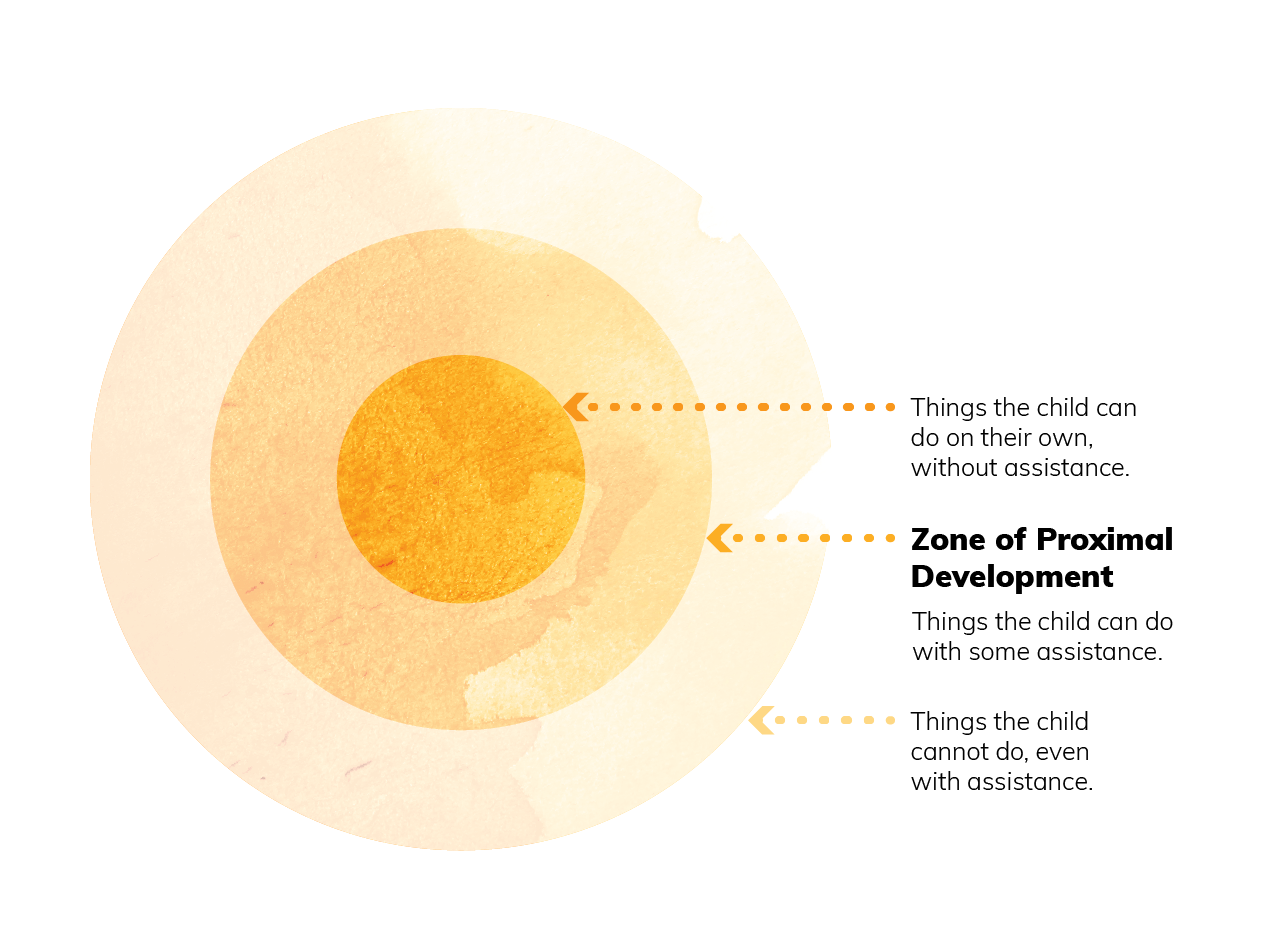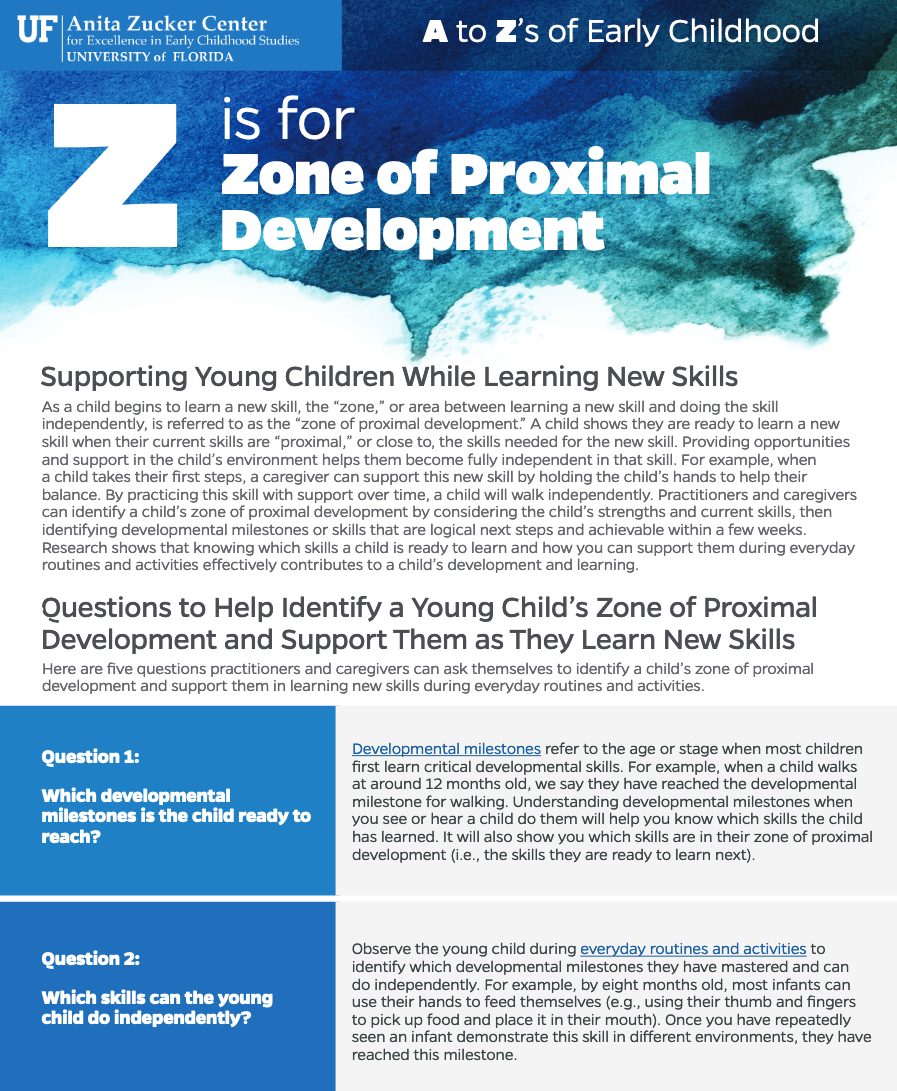A to Z’s of Early Childhood
The Science of Child Development and Learning
Z is for Zone of Proximal Development
Supporting Young Children While Learning New Skills
As a child begins to learn a new skill, the "zone," or area between learning a new skill and doing the skill independently, is referred to as the "zone of proximal development." A child shows they are ready to learn a new skill when their current skills are "proximal," or close to, the skills needed for the new skill. Providing opportunities and support in the child's environment helps them become fully independent in that skill. For example, when a child takes their first steps, a caregiver can support this new skill by holding the child's hands to help their balance. By practicing this skill with support over time, a child will walk independently. Practitioners and caregivers can identify a child's zone of proximal development by considering the child's strengths and current skills, then identifying developmental milestones or skills that are logical next steps and achievable within a few weeks. Research shows that knowing which skills a child is ready to learn and how you can support them during everyday routines and activities effectively contributes to a child's development and learning.


Questions to Help Identify a Young Child’s Zone of Proximal Development and Support Them as They Learn New Skills
Here are five questions practitioners and caregivers can ask themselves to identify a child's zone of proximal development and support them in learning new skills during everyday routines and activities.
Question 1. Which developmental milestones is the child ready to reach?
Developmental milestones refer to the age or stage when most children first learn critical developmental skills. For example, when a child walks at around 12 months old, we say they have reached the developmental milestone for walking. Understanding developmental milestones when you see or hear a child do them will help you know which skills the child has learned. It will also show you which skills are in their zone of proximal development (i.e., the skills they are ready to learn next).
Question 2. Which skills can the young child do independently?
Observe the young child during everyday routines and activities to identify which developmental milestones they have mastered and can do independently. For example, by eight months old, most infants can use their hands to feed themselves (e.g., using their thumb and fingers to pick up food and place it in their mouth). Once you have repeatedly seen an infant demonstrate this skill in different environments, they have reached this milestone.
Question 3. Which skill is the young child ready to learn?
Identify a skill or milestone that is one or two steps ahead of what the child can do independently. For example, suppose an infant can use gestures to request “more” for different objects across environments. In that case, you may begin supporting the infant to pair “more” with the name of things they commonly request using signs or words (e.g., more “milk”). This skill would be within the infant’s zone of proximal development: it builds on what they can already do independently (i.e., gesturing for more milk) and expands their skills by adding the word “milk.”
Question 4. How can the young child's learning of a new skill be scaffolded?
Scaffolding a child’s learning of a new skill means modeling or offering them other environmental supports to help them practice the skill within their zone of proximal development. As a child becomes fluent in their skill use, provide less support. For example, a toddler who can hold a spoon might be ready to apply that skill to feed themselves. Place your hand over their hand as you guide the spoon to scoop the food and bring it to their mouth. Provide this help repeatedly, then see if the toddler can perform the skill independently (i.e., without support).
Question 5. How can I offer the child additional opportunities to learn the new skill in everyday routines and activities?
Often a child learns a new skill within an activity or routine with the support of someone independent in that skill. For example, consider a preschooler learning print concepts (e.g., holding a book right-side-up with two hands). They can learn to hold the book correctly during routines and activities where adults or peers are modeling the skill (e.g., during shared reading at bedtime). Ensure embedded learning opportunities from practitioners, caregivers, or peers are available to support a young learner and create additional opportunities to learn new skills during everyday routines and activities.
What We Are Doing
Learn More:
Embedded Instruction
Embedded Instruction for Early Learning is recognized as a recommended practice nationally and internationally. The Center and our collaborators have received continuous support for Embedded Instruction for Early Learning from local, state and national sponsors since 2007. It is vital for people who regularly interact with young children to learn how to do embedded instruction because children learn best during everyday routines and activities with people and things that are part of everyday life.
Other Resources
CDC's Developmental Milestones
To learn more about developmental milestones, visit the Centers for Disease Control and Prevention Developmental Milestones web page, where you can download a free milestone tracker app that can be personalized for each child.
Rocking and Rolling: Empowering Infants' and Toddlers' Learning Through Scaffolding
In this resource from the National Association for the Education of Young Children, scaffolding refers to embedded learning opportunities that empower infants and toddlers.
What is Instructional Scaffolding?
This module from Vanderbilt's IRIS Center focuses on instructional support through scaffolding in preschool classroom settings.
Books and Articles by Center Members and Collaborators
- Barton, E. E., Bishop, C. C., & Snyder, P. (2014). Quality instruction through complete learning trials: Blending intentional teaching with embedded instruction. In K. Pretti Frontczak, J. Grisham-Brown, & L. Sullivan (Eds.), Blending practices for all children: Young Exceptional Children Monograph Series (No. 16, pp. 73-96). Division for Early Childhood.
- McLaughlin, T., Aspden, K., & Snyder, P. (2016). Intentional teaching as a pathway to equity in early childhood education: Participation, quality, and equity. New Zealand Journal of Educational Studies, 51(2), 175-195. https://doi.org/10.1007/s40841-016-0062-z
- McLaughlin, T., Snyder, P., & Hemmeter, M. L. (2011, September/October). Using embedded instruction to support young children’s learning. Child Care Exchange, 53-56. http://www.exchangepress.com/article/using-embedded-instruction-to-support-young-childrens-learning/5020149/
- McLaughlin, T., & Snyder, P. (2014). Using embedded instruction to enhance social- emotional skills. In J. E. Hart & K. J. Whalon (Eds.), Friendship 101: Helping students build social competence (DADD Prism Series Vol. 8, pp. 63-78). Council for Exceptional Children.
- Snyder, P. A., McLaughlin, T., & Bishop, C. (2018). Maximizing contextually relevant learning opportunities through embedded instruction. In P. A. Snyder & M. L. Hemmeter (Eds.), Instruction: Effective strategies to support engagement, learning, and outcomes: DEC Recommended Practices Monograph Series (No. 4, pp. 51-64). Division for Early Childhood.
- Snyder, P., McLaughlin, T., & Denney, M. (2011). Frameworks for guiding program focus and practices in early intervention. In J. M. Kauffman & D. P. Hallahan (Series Eds.), & M. Conroy (Section Ed.), Handbook of special education: Section XII. Early identification and intervention in exceptionality (pp. 716-730). Routledge.
- Snyder, P., Hemmeter, M. L., McLean, M. E., Sandall, S. R., & McLaughlin, T. (2013). Embedded instruction to support early learning in response to intervention frameworks. In V. Buysse & E. S. Peisner-Feinberg (Eds.), Handbook of response to intervention in early childhood (pp. 283-300). Brookes.
References
- Bruner, J. S. (1978). The role of dialogue in language acquisition. In A. Sinclair, R. J. Jarvella, & W. J. Levelt (Eds.), The child’s conception of language (pp. 241-256). Springer. https://doi.org/10.1007/978-3-642-67155-5
- Vygotsky, L. S. (1978). Mind in society: The development of higher psychological processes (M. Cole, V. John-Steiner, S. Scribner, & E. Souberman, Eds.) Harvard University Press.
Receive Additional Support
The complete 3R’s of Early Learning downloadable video recordings (including the A to Z’s of Early Childhood) for use in the field of childhood development to facilitate learning are available for purchase.
If you would like to purchase these resources or speak with a member of our team for help in providing professional development, please complete this contact form.

